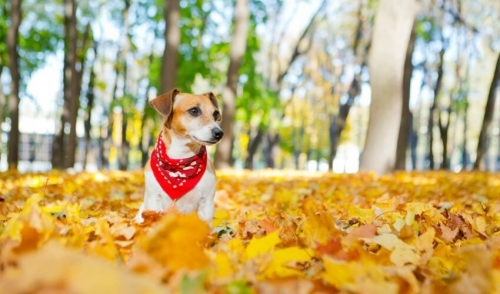
Fall is a fun season to get out and about with your pets, but before you jump into that first pile of leaves, sip that first pumpkin spice latte, or walk down that first fall trail, it is important to keep your pets safe. Understanding autumn hazards and how to avoid them is essential for both you and your pet to safely enjoy fall.
Fall Hazards Pets Face
The exact hazards your pet may face as sunlight wanes and temperatures fall will depend not only on what pet you have, but also its general health, your local climate, and what activities you and your pet enjoy. The most common hazards that affect pets in autumn include:
- Rodenticides: Autumn is when more mice, rats, and other rodents seek shelter in homes, and therefore more poisons and traps are put out for them. These pest control methods are just as dangerous and deadly to pets as they are for any unwanted guests.
- Fleas and Ticks: While these biting pests are dwindling in fall, they can still be active, particularly in warmer climates. Fleas and ticks may be especially fierce in piles of leaves and other debris in fall, and can easily infest pets that spend more time outdoors.
- Cold Snaps: Any outdoor pets are at risk if there is a sudden autumn cold snap. Dropping temperatures can cause hypothermia or frostbite, and even mildly colder temperatures can aggravate some pets’ health conditions, such as arthritis or joint problems.
- Furnace Heat: Small pets can suffer when you turn on furnace heat in the fall, particularly if their cages, crates, tanks, or aquariums may be near vents. Drier air caused by home heating can also impact pets, causing skin irritation, allergy flare-ups, and other discomfort.
- Holiday Treats: Fall is the start of the holiday treat season, with pumpkin spice goodies of all sorts followed by Halloween candy, Thanksgiving feasts, and other rich and delicious dishes. Many of these foods, however, including chocolate, fat, and spices, can be highly toxic to pets.
- Dangerous Decorations: Different decorations popular for autumn holidays can be dangerous to pets. Light strands present electrical hazards, open candle flames are fire risks, and different decorations can have sharp edges, glass parts, or toxic paints and dyes.
- School Supplies: Fall is back-to-school season, but if pets get into an open backpack or desk, they could ingest toxic markers, the blades of pencil sharpeners, or unsafe glue. Even wire-bound notebooks or items for school projects can pose choking or toxic hazards to pets.
- Wildlife: Raccoons, snakes, skunks, and other animals are more active in fall as they feed heavily and look for spaces to hibernate. If pets come across these wild guests, they can be at risk from injuries or disease transmission.
- Darkness: As the days grow shorter in autumn, that early morning or evening walk may be taking place in nearly complete darkness. This makes pets harder to see if they accidentally slip loose, and they could be at risk from vehicles or simply getting lost.
Keeping Your Pet Safe in Fall
Despite all the hazards of the season, it isn’t difficult to keep your pets safe in fall when you take precautionary steps to keep them secure. To protect your pets…
- Keep all chemicals and pesticides securely out of pets’ reach at all times.
- Check your vehicles for fluid leaks and be sure spills are cleaned up immediately.
- Insulate your doghouse or add a windbreak to provide weather protection to an outdoor run.
- Swap pet bedding for heavier, warmer blankets as seasonal temperatures drop.
- Move cages, crates, tanks, and other enclosures away from heating vents.
- Keep all snack foods and special treats out of reach of pets.
- Clean up windfall fruits or fallen nuts so pets do not accidentally snack on them outdoors.
- Opt for pet-friendly holiday decorations, but still keep them safely out of reach.
- Keep school supplies in designated places away from pets.
- Do not allow pets to jump in unknown leaf piles that might hide wildlife or ticks.
- Choose leashes, collars, and other gear with reflective markings for better visibility.
- Reinforce all your pet’s training, including “stay” “no” and “drop” commands.
- Update your pet’s microchip information and be sure you have a current photo just in case.
One of the best things you can do to safeguard your pet during fall – and throughout the year – is to stay alert to their condition and surroundings. When you notice a change, such as limping, breathing difficulties, fur loss, nervous behavior, fear, etc., you can take care of any problems immediately, before they become life-threatening hazards. With care, you and your pet will have many awesome autumns to enjoy together.







Comments